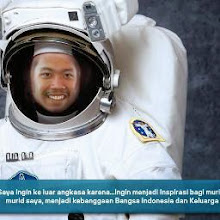Visi
Untuk Menciptakan Kemajuan dalam Bidang Ilmu Pengetahuan, Teknologi Kebumian dan Antariksa demi Keselamatan serta Kesejahteraan Umat Manusia
Misi
1. Inovasi dalam IPTEK Laboratorium Digital Kebumian dan Keantariksaan
2. Penelitian dalam IPTEK Laboratorium Digital Kebumian dan Keantariksaan
3. Pengembangan dalam IPTEK Laboratorium Digital Kebumian dan Keantariksaan
4. Pendidikan dalam IPTEK Laboratorium Digital Kebumian dan Keantariksaan
Program
1. Pembelajaran Teknik Geologi
2. Pembelajaran Geografi dan Lingkungan
3. Pembelajaran Fisika Antariksa
Fokus
1. Sumber: Wikipedia oleh Ade Akhyar
Geomorfologi adalah ilmu yang mendeskripsikan, mendefinisikan, serta menjabarkan bentuk lahan dan proses-proses yang mengakibatkan terbentuknya lahan tersebut, serta mencari hubungan antara proses-proses dalam susunan keruangan (Van Zuidam, 1977).
Berdasarkan sedikit penjelasan di atas, perlu ketahui uraian yang lebih detail lagi beberapa hal yang sangat perlu kita ketahui dalam mempelajari geomorfologi, diantaranya:
2. The complexity of the Earth system, in which spatial and temporal variability exists on a range of scales, requires that an organized scientific approach be developed for addressing the complex, interdisciplinary problems that exist, taking good care that in doing so there is a recognition of the objective to integrate science across the programmatic elements towards a comprehensive understanding of the Earth system. In the Earth system, these elements may be built around aspects of the Earth that emphasize the particular attributes that make it stand out among known planetary bodies.
These include the presence of carbon-based life; water in multiple, interacting phases; a fluid atmosphere and ocean that redistribute heat over the planetary surface; an oxidizing and protective atmosphere, albeit one subject to a wide range of fluctuations in its physical properties (especially temperature, moisture, and winds); a solid but dynamically active surface that makes up a significant fraction of the planet’s surface; and an external environment driven by a large and varying star whose magnetic field also serves to shield the Earth from the broader astronomical environment.
These include the presence of carbon-based life; water in multiple, interacting phases; a fluid atmosphere and ocean that redistribute heat over the planetary surface; an oxidizing and protective atmosphere, albeit one subject to a wide range of fluctuations in its physical properties (especially temperature, moisture, and winds); a solid but dynamically active surface that makes up a significant fraction of the planet’s surface; and an external environment driven by a large and varying star whose magnetic field also serves to shield the Earth from the broader astronomical environment.
- Atmospheric Composition is focused on the composition of Earth's atmosphere in relation to climate prediction, solar effects, ground emissions and time.
- Our weather system includes the dynamics of the atmosphere and its interaction with the oceans and land. The improvement of our understanding of weather processes and phenomena is crucial in gaining an understanding of the Earth system.
- NASA's role in climate variability study is centered around providing the global scale observational data sets on oceans and ice, their forcings, and the interactions with the entire Earth system.
d.Water & Energy Cycles
- Through water and energy cycle research we can improve hurricane prediction, quantify tropical rainfall and eventually begin to balance the water budget at global and regional scales.
e.Carbon Cycle & Ecosystems
- This Focus Area deals with the cycling of carbon in reservoirs and ecosystems as it changes naturally, is changed by humans, and is affected by climate change.
- The goal of the Earth Surface and Interior focus area is to assess, mitigate and forecast the natural hazards that affect society, including earthquakes, landslides, coastal and interior erosion, floods and volcanic eruptions.
Geophysics at Harvard
- Lithosphere Dynamics and Theoretical Geomorphology We work to understand what contemporary fault system activity tells us about earthquake cycle processes, seismic hazard, lithospheric rheology, and the tectonic development of continents.
Associate Professor Brendan J. Meade. - Geodynamics, Planetary Magnetism, and Core Dynamics Our work centers on the study of the Earth and other planets from inner cores to outer boundaries. We place particular emphasis on the characteristics of convection and its dynamical consequences in the core and mantle, as well as on the properties of planetary magnetic fields, its origins and modeling.
Professor Jeremy Bloxham / Professor Richard J. O'Connell. - Seismology We use recordings of seismic energy to image the internal structure of the Earth and to study properties of earthquakes. Different geophysical data can be deciphered to obtain pictures of the Earth's interior without sending instruments deep down. Seismological observations are particularly suitable for such study, and allow us to see the internal structure from different angles. These data also contain clues about source of the energy, i.e., how the Earth slipped to cause earthquakes.
Associate Professor Miaki Isihii / Professor Emeritus Adam Dziewonski. - Theoretical Mechanics We address problems in the theoretical mechanics of solids and fluids, that is, problems of stressing, deformation, fracture and flow, as they arise in seismology, tectonophysics and surficial geologic processes and in civil/environmental engineering hydrology and geomechanics.
Professor James R. Rice. - Sea Level- and Solid Earth DynamicsOur research combines theoretical descriptions and numerical predictions of the response of sufficiently general planetary models with observational constraints from sources as varied as geological reconstructions of lithospheric dynamics, and space geodesy, very-long-baseline interferometry (VLBI) and Global Positioning System (GPS) surveying
Professor Jerry X. Mitrovica.
Founder by:
1. Ade Akhyar Nurdin
The Last Geolog in the World
2. Arip Nurahman
3. Ridwan Firdaus
Thanks To:
3. Earth - NASA Science
Powered by:
1. Museum Geologi Bandung
2. Laboratorium Ilmu Pengetahuan Bumi dan Antariksa, Pendidikan Fisika. FPMIPA. UPI Bandung
3. Departemen Teknik Geologi UNSOED
4. Departemen Pendidikan Geografi Universitas Negeri Jakarta
























